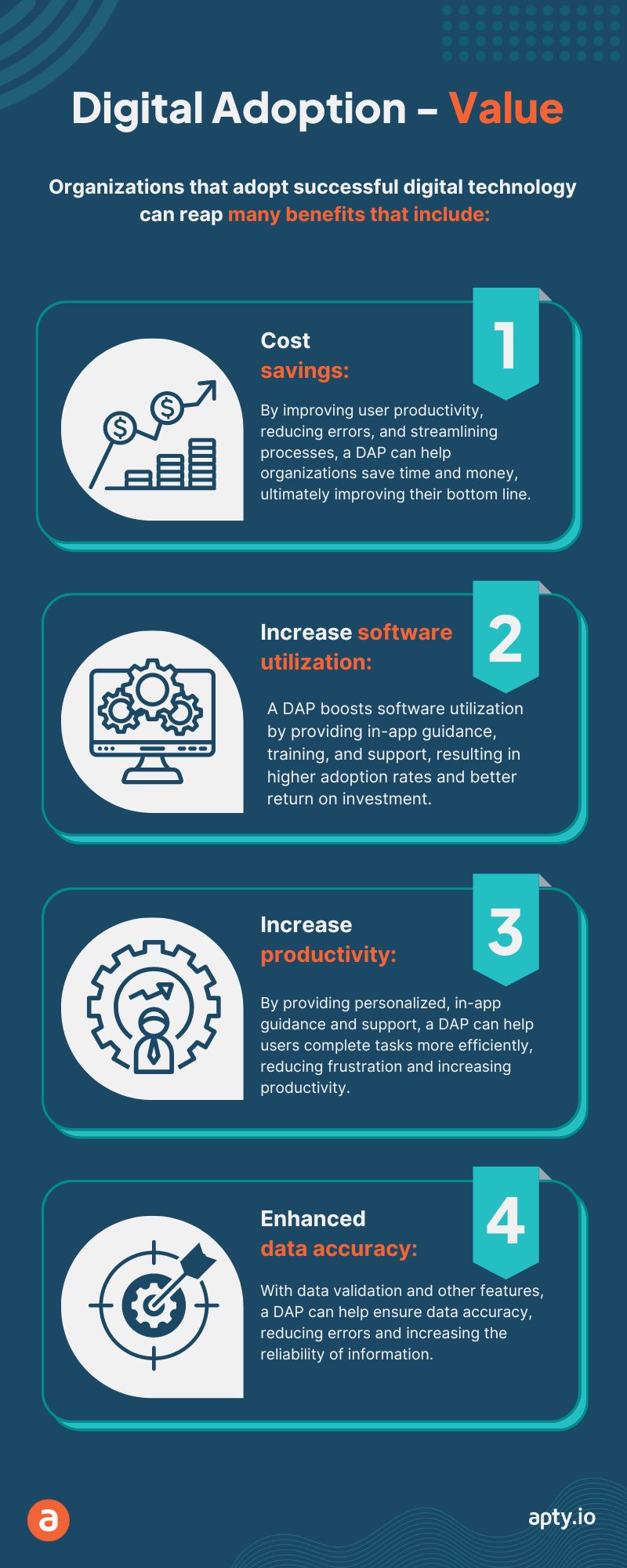Why Enterprises are Prioritizing Software Adoption in 2024
Digital adoption (or software adoption) in the age of technology may appear effortless, but the reality is quite different. The rapid proliferation of software applications has made it easier for companies to acquire new tools, but it has also intensified the challenge of ensuring effective usage and adoption.
More than just purchasing software is required to make employees productive. The key lies in implementing efficient onboarding processes and achieving comprehensive Digital adoption. Without proper utilization, the investment made in acquiring new applications can be rendered futile.
Companies must focus on the following aspects to realize a return on their technology investment:
- Maximizing software utilization: It is essential to ensure that employees fully leverage the capabilities of new software and digital tools. This requires comprehensive training and support to enable users to utilize the applications to their fullest potential.
- Enhancing processes and compliance through technology: Companies leverage technology to streamline and update their existing processes. When launching new software, make sure you’re re-evaluating your processes. Utilize the technology to your advantage, and keep the tech from adhering to outdated workflows. Integrating your software into other applications, tech stacks, and business processes while optimizing and automating processes drives operational efficiency, productivity, and cost savings.
- Transforming interactions with customers and employees: Technology can enable companies to reshape how they engage with customers and employees. Businesses can enhance customer satisfaction and employee engagement by embracing digital channels, self-service options, and personalized experiences.
In essence, facilitating digital adoption among users and employees is critical for business success in the digital era. By prioritizing comprehensive training, seamless onboarding, and effective utilization of software and digital tools, companies can unlock the full potential of their investments and drive organizational growth.
What is Digital adoption?
Digital adoption refers to achieving a state where individuals possess the necessary skills and knowledge to effectively and fully utilize applications, software, or digital tools. It enables users to leverage technology to its maximum potential, allowing them to perform a wide range of digital tasks and processes to improve productivity, increase job performance, and achieve department and Organizational goals.
To ensure business process compliance, manage data integrity, and achieve a successful digital transformation, it all starts with digital adoption.
Organizations’ employees need to adopt digital technologies that facilitate and enforce standardized processes. With software adoption tools, leaders can enforce proper business processes through guided flows, field validations that prevent users from moving forward with missing data, and in-app educational materials about workflow and processes. Software adoption tools enable the automation of workflows, reducing the risk of human error and ensuring consistent adherence to established guidelines and regulations. By digitizing processes, organizations can establish clear audit trails, monitor activities in real time, and generate accurate and timely compliance reports. This simplifies compliance management and enhances transparency and accountability across the organization.

Digital adoption also plays a crucial role in maintaining data integrity. With data’s increasing volume and complexity, manual data entry and management can be prone to errors and inconsistencies. Organizations can adopt digital technologies to implement data validation mechanisms, governance frameworks, and automated data quality checks. This ensures that data is accurate, complete, and up to date, leading to reliable insights and informed decision-making. True digital adoption enables secure storage, efficient data retrieval, and advanced data analytics, further enhancing data integrity and empowering organizations to derive actionable insights from their data assets.
What is true digital adoption?

When users understand the value of the technology or software and fully utilize the tool and all of its features correctly, they can improve their productivity, accuracy, and efficiency to meet business and department goals.

Furthermore, digital adoption is a fundamental component of successful digital transformation initiatives. It involves embracing digital tools, reimagining processes, and fostering a digital culture within the organization. By adopting digital technologies, organizations can streamline operations, enhance collaboration, and unlock new opportunities for innovation. This allows businesses to leverage emerging technologies such as artificial intelligence, cloud computing, and the Internet of Things (IoT), which can revolutionize how they operate and deliver value to customers. Digital adoption paves the way for a comprehensive digital transformation, empowering organizations to stay agile, responsive, and competitive in the digital age.
Suppose you don’t prioritize digital adoption for each digital transformation. In that case, you risk workforce resistance, decreased return on investment, stalled implementations and rollouts, outdated business processes, and increasing employee churn due to bad user experiences that hinder productivity. To truly adopt technology, the user must first understand all its features, modules, and benefits and how it can positively affect their everyday tasks.
For instance, consider the example of using an iPad. Suppose an individual only uses it for browsing the internet and does not explore its capabilities for other activities such as finding directions, booking accommodations, ordering food, playing games, or completing work-related tasks like working with spreadsheets or coding. In that case, digital adoption is not achieved. In this case, the device is not utilized to its fullest potential.
Similarly, in a business context, software adoption is only achieved if an organization’s software and tech stack implemented are fully utilized and leveraged to their maximum capabilities. Merely having software in place does not guarantee its effective utilization. It requires proper training, support, and a comprehensive understanding of the software’s functionalities and features.
Achieving digital adoption is crucial for businesses as it allows them to maximize the value of their technology investments, improve operational efficiency, enhance productivity, and drive business growth. It involves providing users with the necessary resources, guidance, and training to effectively navigate and utilize digital tools in their daily workflows.
Why is Digital Adoption Important?

In the past few years, businesses faced unexpected challenges and disruptions that forced them to embrace digital changes. Currently, the digital economy constitutes over 65% of the global economy, and global investment in digital transformation services and technology is expected to reach $2.3 trillion by 2023.
The proliferation of applications organizations use has grown significantly, and this trend is expected to continue. These modern applications offer efficiency, agility, productivity, and, most importantly, improved return on investment (ROI). According to a Gartner survey, 56% of CEOs said digital improvements have led to revenue growth.
According to Productiv data, the average enterprise has around 364 SaaS apps. According to Asana’s Anatomy of Work Index 2021 report, employees interface with an average of 13 apps 30 times per day. The data also reveals that the average percentage of engaged users across all apps is only 45%.
Despite the substantial investment in software, companies are wasting 37% of their software spending. In the United States alone, the cost of unused software amounts to $30 billion. This indicates that organizations are not fully utilizing their application stack.
Many people might attribute this issue to onboarding, training, or even the software itself, but the truth lies elsewhere.
“Productiv data reveals that, as of 2022, 53% of enterprise apps aren’t managed (meaning no one pays close attention to things like renewal dates, licenses, app usage, security, and compliance). In fact, for at least the last three years, shadow IT has accounted for more than half of the apps in the average SaaS portfolio.”
To address this challenge, enterprises prioritize the development of a software adoption strategy that enables them to leverage their application stack fully. When employees only use a fraction of the features available in enterprise applications, businesses fail to realize the intended value of their software investments.
Top Reasons Enterprises are Prioritizing Digital Adoption in 2024
Digital adoption has become increasingly important for businesses in the modern era, and there are several compelling reasons why organizations must embrace digital technologies to remain competitive and relevant.
Here are some key reasons why executives are prioritizing digital adoption:
- Improved Efficiency: By leveraging digital technologies, businesses can automate tasks, streamline workflows, and increase overall efficiency and productivity. This allows employees to focus on more strategic and high-value activities, driving business growth.
- Cost Savings: Digital adoption reduces costs by eliminating manual processes, minimizing the risk of errors and rework, and optimizing resource allocation. Organizations can save on staffing needs, paper usage, and other operational expenses, resulting in significant cost savings.
- Enhanced Customer Experience: Digital adoption enables businesses to deliver an exceptional customer experience. Self-service portals, real-time tracking of orders and shipments, personalized recommendations, and responsive customer support through technologies like chatbots contribute to a seamless and satisfying customer journey.
- Competitive Advantage: In today’s fast-paced and evolving business landscape, organizations that embrace digital technologies gain a competitive edge. Digital adoption allows businesses to innovate, adapt quickly to market demands, and differentiate themselves from competitors, attracting and retaining customers.
- Business Resilience: The COVID-19 pandemic highlighted the importance of digital adoption for business resilience. Organizations that had already adopted digital technologies were better equipped to adapt to remote work, online transactions, and other digital disruptions. Digital adoption ensures business continuity and agility in the face of unexpected challenges.
Top Risks Enterprises Face if They Don’t Consider True Software Adoption
Furthermore, the lack of proper software management and adoption poses significant organizational risks. When applications are not effectively managed, organizations face a range of issues, including:
- Wasted Resources: Unused or underutilized software leads to wasted resources in terms of financial investment and the potential value that could have been derived from the software. This inefficient allocation of resources hampers business growth and reduces the overall return on investment.
- Missed Opportunities: Failing to fully adopt and leverage digital technologies means missing out on valuable opportunities for innovation, process improvement, and competitive advantage. Organizations that do not maximize their software usage are at a disadvantage compared to their competitors, who effectively utilize digital tools to drive growth.
- Inefficiencies and Fragmentation: When employees use only a fraction of the available features and capabilities of enterprise applications, it results in inefficiencies and fragmented workflows. This can lead to disjointed processes, duplicated efforts, and decreased collaboration across teams, hindering productivity and hindering the achievement of strategic objectives. One way to solve this is by implementing cross-functional communications with an integrated software adoption tool that can lead to cross-departmental opportunities, decreased siloed thinking, and increased process efficiencies and accuracy.
- Security and Compliance Risks: Inadequate management of software applications can expose organizations to security vulnerabilities and compliance risks. Unmanaged applications may not receive timely updates and patches, making them more susceptible to cyber threats. Additionally, non-compliance with licensing agreements and regulatory requirements can result in legal consequences and reputational damage. IT departments also face risks when inundated with API integration requirements that may not meet industry, company, or platform requirements and standards. Utilizing feedback loops, documentation, QA, and secure cloud-based or on-prem solutions can mitigate some of these issues.
Why CTOs & CIOs Consider Digital Adoption Platforms as Essential for Successful Digital Transformations in 2024

Digital transformation is a complex undertaking, leading organizations to establish the Chief Transformation Officer (CTO) role to oversee the successful implementation of technology-driven changes. A well-defined agenda, goals, and digital adoption plan are essential for achieving the desired transformation. Without proper adoption of implemented applications or software, digital transformation initiatives can fall short.
To ensure the effective utilization of technology and maximize digital transformation efforts, CTOs, and CIOs seek solutions that promote proper adoption and adherence to implemented business processes. This is where Digital Adoption Platforms (DAPs) come into play. DAPs, or software adoption solutions, are intelligent tools that seamlessly facilitate digital transformation within organizations.
Software adoption platforms have emerged over the past 5 to 10 years as a response to the growing need for supporting adoption and user onboarding. Initially, DAP products offered minimal on-screen guidance for web-based applications. However, today, DAP solutions have evolved and become indispensable for successful digital transformation.
As applications undergo frequent updates and the number of applications each user uses increases, managing training and onboarding for individual job roles and applications becomes challenging for administrators, users, and trainers. DAP solutions help streamline the onboarding process, reduce dependencies, and ensure a smooth transition. They offer numerous benefits, such as saving time and money, enhancing employee productivity, and utilizing analytics to provide an improved user experience.
It is crucial to understand the significance of a Digital Adoption Platform and how it can address organizational challenges. With many options available in the market, selecting the right DAP that aligns with specific business needs can be overwhelming.
Apty uses a unique data-centric approach. It analyzes how implemented applications are being used and identifies bottlenecks faced by users. Based on this analysis, Apty creates targeted walkthroughs and guidance to address those challenges effectively.
By leveraging a Digital Adoption Platform like Apty, organizations can streamline their digital transformation efforts, enhance user adoption, improve productivity, and ensure a successful transition to a digitally empowered organization.
Why Enterprises Prioritize Digital Adoption?
Digital adoption is crucial now due to several factors that have shaped the business landscape, including technological advancements and unforeseen events such as natural calamities. Here are some reasons why executives find digital adoption essential in 2024:
- Technological Advancements: Rapid technological advancements have introduced new tools and applications that offer opportunities for businesses to optimize their processes and improve performance. Embracing and effectively adopting these tools is necessary to stay competitive and maximize return on investment.
- Digital Transformation: Organizations are increasingly undergoing digital transformation initiatives, which involve shifting from traditional ways of doing things to leveraging digital technologies across the entire organization. Digital adoption is essential for a smooth transition, ensuring employees understand and embrace the technical and cultural changes associated with the transformation.
- Enhanced Performance: Organizations can enhance their overall performance by promoting software adoption. CIOs are tasked to do more with less, and by ensuring software adoption, they can reduce shelfware and increase software ROI. When employees fully utilize digital tools and applications, they become more efficient, productive, and capable of achieving better outcomes. Software adoption enables organizations to harness the full potential of technology to drive success.
- Hybrid Workforce: The rise of hybrid work models, with a mix of remote and in-office employees, has increased reliance on technology for collaboration and communication. Proper digital adoption and guidance ensure a seamless onboarding experience for this evolving workforce, enabling them to effectively utilize digital tools regardless of location.
- Data Integrity: Proper software adoption ensures process compliance and reduces human error, leading to accurate and real-time data. In today’s dynamic and competitive business environment, organizations rely on clean data to make informed decisions that impact their operations, including profit margins, sales pipeline, revenue forecasting, and more. Digital adoption safeguards data integrity, enabling agile decision-making and driving overall business success.
To facilitate successful digital adoption, organizations can deploy various strategies and resources, including:
- Classroom Training: Conduct training sessions where employees can learn about the new tools and applications through instructor-led sessions.
- Online Training: Provide online training resources, such as e-learning modules, videos, and interactive tutorials, to enable employees to learn at their own pace and convenience.
- Knowledge Transfer: Encourage knowledge sharing among employees to foster collaboration and create a culture of continuous learning.
- Documentation: Develop comprehensive documentation and user guides that provide step-by-step instructions and reference materials for employees to refer to when using the new tools.
- Digital Adoption Platforms: Implement a digital adoption platform that offers contextual guidance, interactive walkthroughs, and on-screen prompts to help users navigate and effectively utilize software applications. These software adoption tools ensure process compliance and data integrity through field validations, automated processes, and self-paced learning.
By embracing these approaches and investing in digital adoption, organizations ensure their employees have the necessary skills and knowledge to leverage technology effectively, driving business growth and success in the ever-evolving digital landscape.
The Way Ahead for Digital Adoption Platforms
Digital adoption strategies have become indispensable for businesses aiming to gain a competitive edge in today’s evolving landscape. They recognize the importance of providing digital assistance and walkthroughs to facilitate the onboarding process for employees and customers.
To ensure the success of their digital transformation efforts, organizations are transitioning from traditional Learning Management Systems (LMS) to more dynamic Learning Experience Systems (LXP). Additionally, they are complementing these systems with Digital Adoption Platforms (DAPs) to provide real-time guidance and support to users.
In a rapidly changing world, DAPs are vital in guiding users, whether they are located remotely or within the organization. Solutions like Apty offer seamless guidance and support, empowering users to navigate complex digital environments effectively.
Organizations can stay ahead of the curve by adopting a DAP and be well-prepared for current and future digital challenges. The future of digital transformation looks promising as digital adoption becomes more accessible and achievable with the assistance of Digital Adoption Platforms.
Table of Contents
- Why Enterprises are Prioritizing Software Adoption in 2024
- What is Digital adoption?
- What is true digital adoption?
- Why is Digital Adoption Important?
- Top Reasons Enterprises are Prioritizing Digital Adoption in 2024
- Top Risks Enterprises Face if They Don’t Consider True Software Adoption
- Why CTOs & CIOs Consider Digital Adoption Platforms as Essential for Successful Digital Transformations in 2024
- Why Enterprises Prioritize Digital Adoption?
- The Way Ahead for Digital Adoption Platforms
- Start your digital adoption journey today!
- 2023 Enterprise Software Trends in the Airline Industry
- 8 Tips to Maximizing ROI of ERP Implementation: Strategies for Reducing Operating Costs
- Disruptive Change: Why 70% of the organizations fail











